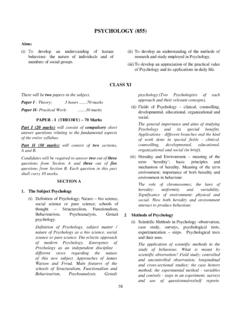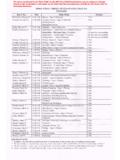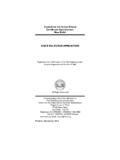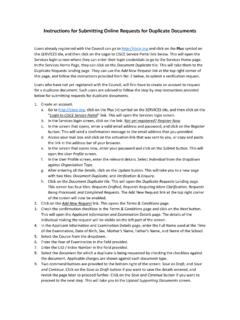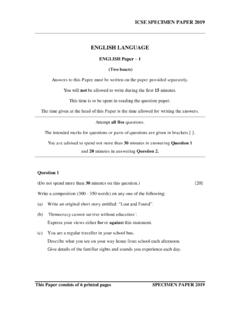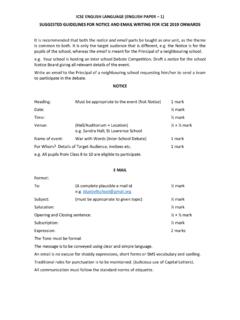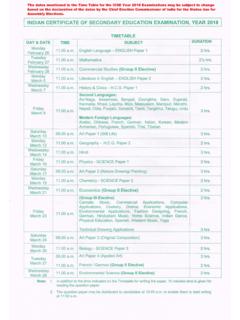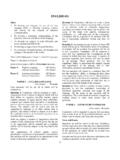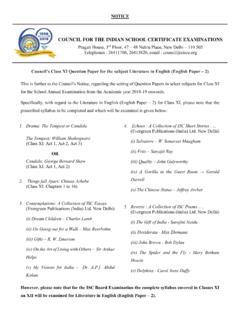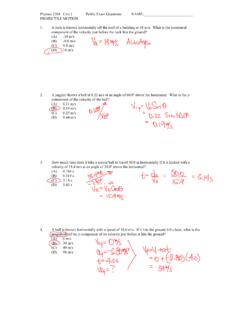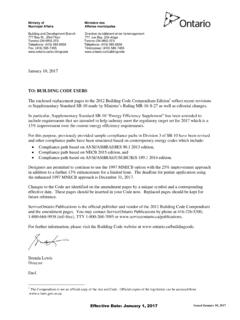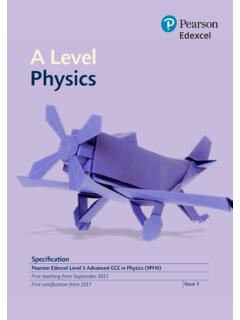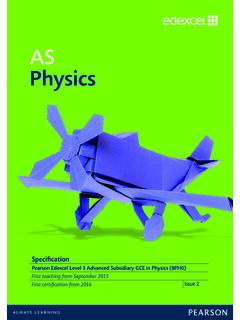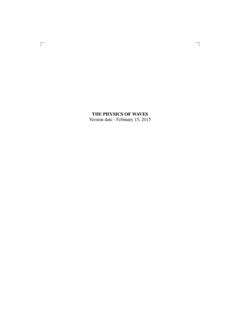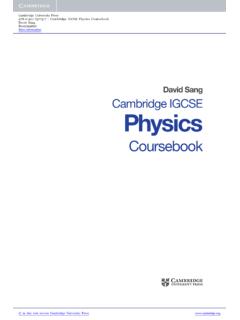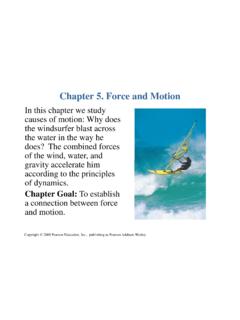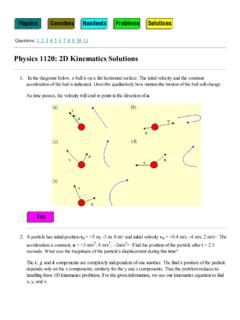Transcription of SCIENCE (52) - CISCE
1 SCIENCE (52). physics . SCIENCE Paper - 1. CLASS IX. There will be one paper of two hours duration 3. Laws of Motion carrying 80 marks and Internal Assessment of practical work carrying 20 marks. (i) Contact and non-contact forces; cgs & SI. units. The paper will be divided into two sections, Section I (40 marks) and Section II (40 marks). Examples of contact forces (frictional force, normal reaction force, tension force Section I (compulsory) will contain short answer as applied through strings and force questions on the entire syllabus.)
2 Exerted during collision) and non-contact Section II will contain six questions. Candidates forces (gravitational, electric and will be required to answer any four of these six magnetic). General properties of non- questions. contact forces. cgs and SI units of force and their relation with Gravitational units. Note: Unless otherwise specified, only SI Units are to be used while teaching and learning, as well as (ii) Newton's First Law of Motion (qualitative for answering questions. discussion) introduction of the idea of inertia, mass and force.
3 1. Measurements and Experimentation Newton's first law; statement and (i) International System of Units, the required qualitative discussion; definitions of inertia SI units with correct symbols are given and force from first law, examples of at the end of this syllabus. Other inertia as illustration of first law. (Inertial commonly used system of units - fps and mass not included). cgs. (iii)Newton's Second Law of Motion (ii) Simple pendulum (including F=ma); weight and mass. Simple pendulum: time period, frequency, Detailed study of the second law.
4 Linear graph of length l versus T2 only; slope of momentum, p = mv; change in momentum the graph. Formula T=2.. l g [no p = (mv) = m v for mass remaining constant, rate of change of momentum;. derivation]. Only simple numerical problems. p/ t = m v / t = ma or p 2 - p1 mv - mu m ( v - u ). 2. Motion in One Dimension { = = = ma } ;. t t t Scalar and vector quantities, distance, speed, velocity, acceleration; equations of uniformly Simple numerical problems combining accelerated motion without derivations. F = p / t = ma and equations of motion.
5 Examples of Scalar and vector quantities only, Units of force - only cgs and SI. rest and motion in one dimension; distance and (iv) Newton's Third Law of Motion displacement; speed and velocity; acceleration (qualitative discussion only); simple and retardation [Non-uniform acceleration examples. excluded]. Statement with qualitative discussion;. Equations to be learned: v = u + at;. examples of action - reaction pairs, (F BA. S = ut + at2; S = (u+v)t; v2 = u2 + 2aS. and F AB ); action and reaction always act [Equation for S n th is not included].
6 On different bodies. Simple numerical problems. (v) Gravitation Universal Law of Gravitation. (Statement and equation) and its importance. Gravity, 1. acceleration due to gravity, free fall. 5. Heat and Energy Weight and mass, Weight as force of (i) Concepts of heat and temperature. gravity comparison of mass and weight;. gravitational units of force, (Simple Heat as energy, SI unit joule, numerical problems), (problems on 1 cal = J exactly. variation of gravity excluded). (ii) Anomalous expansion of water 4. Fluids Graphs showing variation of volume and (i) Change of pressure with depth (including density of water with temperature in the 0.)
7 The formula p=h g); Transmission of to 10 0C range. Hope's experiment and pressure in liquids; atmospheric pressure. consequences of Anomalous expansion. Thrust and Pressure and their units; (iii) Global warming and Green House effect. pressure exerted by a liquid column p = Scientific definitions of the above. h g; simple daily life examples, (i). broadness of the base of a dam, (ii) Diver's 6. Light suit etc. some consequences of p = h g;. (i) Reflection of light; images formed by a transmission of pressure in liquids;. pair of parallel and perpendicular plane Pascal's law; atmospheric pressure.
8 Mirrors;. common manifestation and consequences. Variations of pressure with altitude, Laws of reflection; experimental (qualitative only); applications such as verification; characteristics of images weather forecasting and altimeter. (Simple formed in a pair of mirrors, (a) parallel numerical problems including Pascal's and (b) perpendicular to each other; uses law) of plane mirrors. (ii) Buoyancy, Archimedes' Principle; (ii) Spherical mirrors; characteristics of image floatation; relationship with density; formed by these mirrors.
9 Uses of concave relative density; determination of relative and convex mirrors. (Only simple direct density of a solid using water only. ray diagrams are required). Buoyancy, upthrust (F B ); definition; Brief introduction to spherical mirrors - different cases, F B >, = or < weight W of concave and convex mirrors, centre and the body immersed; characteristic radius of curvature, pole and principal properties of upthrust; Archimedes' axis, focus and focal length; location of principle; explanation of cases where images from ray diagram for various bodies with density >, = or < the density positions of a small linear object on the ' of the fluid in which it is immersed.
10 Principal axis of concave and convex mirrors; characteristics of images. Relative Density (RD) and Archimedes'. principle, determination of RD of a solid Uses of spherical mirrors. denser than water using water and RD of Scale drawing or graphical representation liquid. Floatation: principle of floatation; of ray diagrams not required. relation between the density of a floating body, density of the liquid in which it is 7. Sound floating and the fraction of volume of the (i) Nature of Sound waves. Requirement of a body immersed; ( 1 / 2 = V 2 /V 1 ); apparent medium for sound waves to travel.
